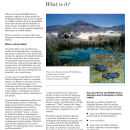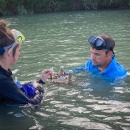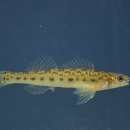When a species is proposed for listing as endangered or threatened under the Endangered Species Act (ESA), we identify specific areas that are essential to its conservation. These are the species’ critical habitat.
Critical habitat is a tool that supports the continued conservation of imperiled species by guiding cooperation within the federal government. Designations affect only federal agency actions or federally funded or permitted activities.
For private landowners and citizens
Critical habitat designations do not affect activities by private landowners if there is no federal “nexus”— that is, no federal funding or permits are required to carry out the activity.
Identifying critical habitat informs landowners and the public which specific areas are important to a species’ conservation and recovery. It also raises awareness of the habitat needs of imperiled species and focuses efforts of our conservation partners.
Designation of critical habitat does not:
- Affect land ownership
- Allow the government to take or manage private property
- Establish a refuge, reserve, preserve, or other conservation area conservation area
A conservation area is a type of national wildlife refuge that consists primarily or entirely of conservation easements on private lands. These conservation easements support private landowner efforts to protect important habitat for fish and wildlife and major migration corridors while helping to keep agricultural lands in production.
Learn more about conservation area - Allow government or public access to private land
For federal agencies
Under section 7 of the ESA, all federal agencies are required to use their authorities to help conserve imperiled species. The ESA helps to ensure that the Federal government does not contribute to the decline of endangered and threatened species or their potential for recovery.
Federal agencies are prohibited from destroying or adversely modifying designated critical habitat. This means they must consult with the Service about actions that they carry out, fund, or authorize to ensure that they will not destroy or adversely modify critical habitat.
Even when there is no critical habitat designation, federal agencies are required fulfill their conservation responsibilities by consulting with the Service if their actions “may affect” listed species.
Critical habitat and land development
Critical habitat does not prevent all development or other activities that occur in a designated area.
Only activities that involve a federal permit, license, or funding, and are likely to destroy or adversely modify critical habitat will be affected. If this is the case, the Service works with the agency and landowners to amend the project to enable it to proceed without adversely affecting critical habitat. Most federal projects are likely to go forward, but some may be modified to minimize harm.
Determining Critical Habitat
When determining critical habitat, we first evaluate areas currently occupied by the species and consider what physical and biological features a species needs for life processes and successful reproduction. These features include:
- Space for individual and overall population growth, and for normal behavior
- Cover or shelter
- Food, water, air, light, minerals, or other nutritional or physiological requirements
- Sites for breeding and rearing offspring, germination, or seed dispersal
- Habitats that are protected from disturbances or are representative of the historical geographical and ecological distributions of the species
We only consider designating unoccupied areas as critical habitat when the amount of occupied areas would not be enough to ensure conservation of the species. For an unoccupied area to be designated as critical habitat, we must determine that there is a reasonable certainty that the area will contribute to the conservation of the species and that the area contains one or more of the physical or biological features essential to the conservation of the species.
Designating critical habitat
First, we propose designation of critical habitat for a species in the Federal Register with a request for public comments. We may modify a proposal as a result of information provided in those comments.
We may propose to designate critical habitat for a species at the same time that we propose to list the species, or we can address a species’ critical habitat after a species has been listed.
We base our final designation of critical habitat on the best scientific data available, after taking into consideration the probable economic and other impacts of the designation. After reviewing the comments, the Service responds to them and publishes a rule, including final boundaries, in the Federal Register.
Critical habitat exclusions
An area may be excluded from critical habitat designation based on economic, national security, or other relevant impacts. In some cases, we may determine that the benefits of excluding it outweigh the benefits of including it.
We can also make a determination not to designate critical habitat when a designation would likely increase the threat of collection, vandalism, or incidental habitat degradation by curiosity seekers. Such is the case with the rock gnome lichen, a plant found at just 35 sites in the southern Appalachian Mountains.
See a list of species with critical habitat.
Access an online mapping application that displays designated spatial information for selected critical habitat.












